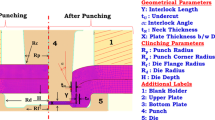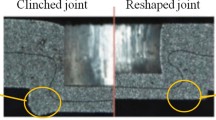Abstract
Mechanical clinching is a process of joining various sheets using a punch and a die and has been widely applied in automobile manufacturing. A rotated clinching process using two rotated heads and a flat-bottomed fixed die was proposed in this study. An experimental device was developed and rotated clinching experiments were conducted on 1.5-mm-thick Al1060 sheets using this approach. Shear and pull-out tests of the joints with various vertical reductions of rotated heads were conducted to evaluate the static joining strength. The failure modes of joints and the geometric characterisation of the joint profile in terms of interlock and neck thickness were analysed. Preliminary test results show that the joint strength exhibited evident directionality, where the force applied in the transverse direction was the largest. The maximum strength was 40% that of the Al1060 sheet. Full tearing failure and partial tearing with unbuttoning failure were the main joint failure modes. With increasing vertical reduction of the rotated heads, the neck thickness changed less and the interlock increased, reaching 33.3% of the lower sheet thickness.
















Similar content being viewed by others
Availability of data and material
All data generated or analysed during this study are included in this published article.
Code availability
Not applicable.
References
Santos M, Machado A, Sales W, Barrozo M, Ezugwu E (2016) Machining of aluminum alloys: a review. Int J Adv Manuf Technol 86:3067–3080. https://doi.org/10.1007/s00170-016-8431-9
Briskham P, Blundell N, Han L, Hewitt R, Boomer D (2006) Comparison of self-pierce riveting, resistance spot welding and spot friction joining for aluminium automotive sheet. SAE Technical Papers 20–34. https://doi.org/10.4271/2006-01-0774
Varis J (2006) Economics of clinched joint compared to riveted joint and example of applying calculations to a volume product. J Mater Process Technol 172:130–138. https://doi.org/10.1016/j.jmatprotec.2005.09.009
Abe Y, Taromaru K, Kato T, Mori K (2011) Improvement of joinability in mechanical clinching of sheets using step punch. Institute of Metal Forming. Special Edition: 10th International Conference on Technology of Plasticity, Aachen, Germany, 667–672
Hamel V, Roelandt JM, Gacel JN, Schmit F (2000) Finite element modeling of clinch forming with automatic remeshing. Comput Struct 77:185–200. https://doi.org/10.1016/s0045-7949(99)00207-2
Paulaa AA, Aguilarb M-T-P, Pertence A-E-M, Cetlin P-R (2007) Finite element simulations of the clinch joining of metallic sheets. J Mater Process Technol 182:352–357. https://doi.org/10.1016/j.jmatprotec.2006.08.014
Oudjene M, Ben-Ayed L (2008) On the parametrical study of clinch joining of metallic sheets using the Taguchi method. Eng Struct 30:1782–1788. https://doi.org/10.1016/j.engstruct.2007.10.017
Lee CJ, Kim JY, Lee SK, Ko DC, Kim BM (2010) Parametric study on mechanical clinching process for joining aluminum alloy and high-strength steel sheets. J Mech Sci Technol 24(1):123–126. https://doi.org/10.1007/s12206-009-1118-5
Mucha J (2011) The analysis of lock forming mechanism in the clinching joint. Mater Des 32:4943–4954. https://doi.org/10.1016/j.matdes.2011.05.045
Kim JY, Lee CJ, Lee SK, Ko DC, Kim BM (2009) Effect of shape parameters of tool on improvement of joining strength in clinching. Trans Mater Proces 18:392–400. https://doi.org/10.5228/KSPP.2009.18.5.392
Coppieters S, Zhang H, Xu F, Vandermeiren N, Breda A, Debruyne D (2017) Process-induced bottom defects in clinch forming: simulation and effect on the structural integrity of single shear lap specimens. Mater Des 130:336–348. https://doi.org/10.1016/j.matdes.2017.05.077
Brzezin´ski T, Ciccoli N, Dabrowski L, Sitarz A (2018) Mechanical clinching with dies for control of metal flow of ultra-high-strength steel and high-strength steel sheets. P I Mech Eng B-J Eng 232(4):644–649. https://doi.org/10.1177/0954405416683429
Abe Y, Mori K, Kato T (2012) Joining of high strength steel and aluminium alloy sheets by mechanical clinching with dies for control of metal flow. J Mater Process Technol 212:884–889. https://doi.org/10.1016/j.jmatprotec.2011.11.015
Lee CJ, Lee JM, Ryu HY, Lee KH, Kim BM, Ko DC (2014) Design of hole-clinching process for joining of dissimilar materials Al6061-T4 alloy with DP780 steel, hot-pressed 22MnB5 steel, and carbon fiber reinforced plastic. J Mater Process Technol 214:2169–2178. https://doi.org/10.1016/j.jmatprotec.2014.03.032
NeugebauerR KC, Dietrich S (2008) Advances in mechanical joining of magnesium. CIRP Ann Manuf Technol 57:283–286. https://doi.org/10.1016/j.cirp.2008.03.025
Gerstmann T, Awiszus B (2014) Recent development in flat-clinching. Comput Mater Sci 81:39–44. https://doi.org/10.1016/j.commatsci.2013.07.013
Atia MKS, Jain MK (2017) Die-less clinching process and joint strength of AA7075 aluminum joints. Thin-Walled Struct 120:421–431. https://doi.org/10.1016/j.tws.2017.06.021
Luder S, Hartel S, Binotsch C, Awiszus B (2014) Influence of the moisture content on flat-clinch connection of wood materials and aluminium. J Mater Process Technol 214:2069–2074. https://doi.org/10.1016/j.jmatprotec.2014.01.010
Han XL, Zhao SD, Chen C, Liu C, Xu F (2017) Optimization of geometrical design of clinching tools in flat-clinching. Proc IMechE C 231:4012–4021. https://doi.org/10.1177/0954406216660335
Chen C, Zhao S, Han X, Wang Y, Zhao X (2020) Investigation of the flat-clinching process for joining three-layer sheets on thin-walled structures. Thin-Walled Struct 157:107034. https://doi.org/10.1016/j.tws.2020.107034
He YL, Huang LJ (2013) An experimental research on quality and strength of aluminous joint by clinch joining technique applied mechanical and material. Appl Mech Mater 389:217. https://doi.org/10.4028/www.scientific.net/amm.389.217
Lambiase F, Di Ilio A (2013) Finite element analysis of material flow in mechanical clinching with extensible dies. J Mater Eng Perform 22:1629–1636. https://doi.org/10.1007/s11665-012-0451-5
Lambiase F, Di Ilio A (2014) An experimental study on clinched joints realized with different dies. Thin-Walled Struct 85:71–80. https://doi.org/10.1016/j.tws.2014.08.004
He X, Liu F, Xing B, Yang H, Wang Y, Gu F, Ball A (2014) Numerical and experimental investigations of extensible die clinching. Int J Adv Manuf Technol 74:1229–1236. https://doi.org/10.1007/s00170-014-6078-y
Han X, Zhao S, Liu C, Chen C, Xu F (2017) Optimization of geometrical design of clinching tools in clinching process with extensible dies. Proc IMechEC 231:3889–3897. https://doi.org/10.1177/0954406216660336
He X, Zhang Y, Xing B, Gu F, Ball A (2015) Mechanical properties of extensible die clinched joints in titanium sheet materials. Mater Des 71:26–35. https://doi.org/10.1016/j.matdes.2015.01.005
Witkowski W (2015) The shear strength of the round clinching joints formed by using extensible dies. Adv Sci Technol Res J 9(26):72–76. https://doi.org/10.12913/22998624/2367
Mucha J (2011) The analysis of rectangular clinching joint in the shearing test. Maint Reliab 3:45–50
Varis JP (2003) The suitability of clinching as a joining method for high-strength structural steel. J Mater Process Technol 132:242–249. https://doi.org/10.1016/s0924-0136(02)00933-0
Zhao L, He XC, Lu Y (2014) Research of mechanical behavior for rounded and rectangular clinched joint. Adv Mater Res 1035:144–148. https://doi.org/10.4028/www.scientific.net/amr.1035.144
Lambiase F (2015) Mechanical behaviour of polymer–metal hybrid joints produced by clinching using different tools. Mater Des 87:606–618. https://doi.org/10.1016/j.matdes.2015.08.037
Funding
This work was financially supported by the National Natural Science Foundation of China (52065014), Natural Science Foundation of Guangxi Province (2017GXNSFAA198133), and Innovation Project of Guangxi Graduate Education (JGY2019074).
Author information
Authors and Affiliations
Contributions
Yulin He conceived and wrote the paper; Lianfa Yang contributed to the data analysis of the manuscript; Pengju Zong designed and performed the experiments; Jing Dang analysed the data; Jianping Ma helped to perform the analysis with constructive discussions.
Corresponding author
Ethics declarations
Ethics approval
Not applicable.
Consent to participate
All authors agreed with the consent to participate.
Consent for publication
All authors have read and agreed to the published version of the manuscript.
Conflict of interest
The authors declare no competing interests.
Additional information
Publisher's Note
Springer Nature remains neutral with regard to jurisdictional claims in published maps and institutional affiliations.
Rights and permissions
About this article
Cite this article
He, Y., Yang, L., Zong, P. et al. Rotated clinching process for two-layer metallic sheets. Int J Adv Manuf Technol 119, 3819–3831 (2022). https://doi.org/10.1007/s00170-021-08474-5
Received:
Accepted:
Published:
Issue Date:
DOI: https://doi.org/10.1007/s00170-021-08474-5




